Isfahan Travel Guide: Top Sights & Tips + Photos
Things to Do in Isfahan – Activities & Attractions

Discover the heart of Persian culture with our comprehensive Isfahan Travel Guide. Located in the center of Iran, Isfahan captivates visitors with its stunning Islamic architecture, vibrant bazaars, and picturesque bridges.
his guide provides essential tips, from exploring the UNESCO-listed Naqsh-e Jahan Square to experiencing traditional Persian tea houses. Perfect for first-time visitors and seasoned travelers alike, our guide ensures you make the most of your Isfahan adventure.
Start planning your journey to one of Iran’s most enchanting cities and uncover the secrets of its rich history and breathtaking landscapes.
Contents
Why Visiting Isfahan
Isfahan, known as the jewel of ancient Persia, stands as Iran’s top destination. Its captivating tree-lined boulevards, verdant Persian gardens, and monumental Islamic buildings set it apart, offering a visual charm unlike any other Iranian city.
The city’s vibrant artisan community further solidifies its reputation as a living museum of traditional culture, blending the past with the present in a dynamic display.
The historic bazaar of Isfahan, a bustling hub of craftsmanship and heritage, offers a window into the rich cultural fabric of the city. Here, visitors can discover the beauty of Persian craftsmanship, from exquisite carpets to hand-painted ceramics, each piece telling a story of tradition and skill.

Crossing Isfahan’s scenic bridges, including the renowned Si-o-se-pol and Khaju, offers moments of peace and reflection. These architectural wonders are not just crossings over the Zayanderud River but are central to the city’s social life, offering breathtaking views and a place for communal gathering.
At the heart of Isfahan’s architectural magnificence is the UNESCO-listed Naqsh-e Jahan Square.
Surrounded by the city’s most splendid Islamic buildings, the square is a hub of historical and aesthetic significance, showcasing the grandeur of the Imam Mosque, the elegance of Sheikh Lotfollah Mosque, and the regal Ali Qapu Palace.

Isfahan captivates visitors by harmoniously weaving its historical essence with the vibrancy of modern life. The city promises not just a journey through its picturesque streets and squares but an unforgettable experience of its beauty and warmth, leaving a lasting impression on all who visit.
Due to its beautiful hand-painted tiling and magnificent public square, it is considered to be one of the most beautiful cities in the world. An ancient town and capital of Persia from 1598 to 1722, it was long noted for its fine carpets and silver filigree.
Today, textile and steel mills take their place. Its architecture, tree-lined boulevards and relaxed pace make it one of the highlights of Iran. The city is 430km south of Tehran at the foothills of the Zagros Mountain range.
The city enjoys a temperate climate and regular seasons. Isfahan is located on the main north-south and east-west routes crossing Iran. It is similar to Denver in the United States in terms of altitude and precipitation. It is the twin city of Freiburg and Freiburg Street in Isfahan is famous.
Best Time to Visit Isfahan
The best time to visit Isfahan is during the spring (March to May) and autumn (September to November) months. During these periods, the weather is mild and pleasant, ideal for exploring the city’s stunning architecture and gardens without the extreme heat of summer or the chill of winter.
Spring brings the added bonus of Nowruz celebrations and the city blooming into vibrant colors, while autumn offers comfortable temperatures and fewer crowds, making it perfect for leisurely walks through Isfahan’s historical sites and bustling bazaars.
| Month | Weather Conditions | Visitor Experience |
|---|---|---|
| January | Cold and clear | Fewer tourists; ideal for enjoying indoor attractions like museums without the crowds. |
| February | Cold to mild, occasional rain | Increasingly pleasant; great for early spring blooms in parks. |
| March | Mild with spring blooms | Perfect for Nowruz (Persian New Year) celebrations; the city is vibrant with festivities. |
| April | Warm and pleasant | Ideal for outdoor activities; the gardens of Isfahan are especially beautiful. |
| May | Warm, getting hotter | Good time for sightseeing before the peak heat; evenings are particularly pleasant. |
| June | Hot | Start early to beat the heat; enjoy late evening walks along the Zayandeh River. |
| July | Very hot | Siesta is common; explore indoor attractions during the day and enjoy cooler evenings outdoors. |
| August | Very hot | Similar to July; consider night-time visits to historical sites when possible. |
| September | Warm, cooling down | The heat begins to subside; perfect for visiting the city’s landmarks without the extreme heat. |
| October | Mild and pleasant | Great weather for outdoor exploration; less crowded than spring. |
| November | Cool to mild | Enjoy the changing leaves in Isfahan’s gardens and parks; cooler but comfortable for sightseeing. |
| December | Cold, clear | Quiet month; ideal for experiencing Isfahan without the crowds, especially appealing for photographers. |

Get Around Isfahan
Isfahan’s public transportation system, featuring buses, taxis, online services like Snap and Tapsi, and the subway, offers a convenient and cost-effective way to discover its attractions. Explore the city’s stunning landscapes and cultural heritage with ease. Learn more about navigating Isfahan.
Get Around Isfahan By Bus
Getting around Isfahan by bus is an efficient and economical option for visitors. The city’s extensive bus network covers major attractions, residential areas, and key points of interest, making it accessible for tourists to navigate the city.

A single journey costs IRR25000 (November 2022); you can pay the driver directly, or buy multi-journey contactless cards at certain bus stop booths.
Note that there are separate men (front) and women (rear) sections on each bus.
From Kaveh Bus Terminal, take Bus 91 which runs down Chahar Bagh-e Pa’in St towards the city center, past Takhti Junction and Imam Hossein Sq.
By Metro
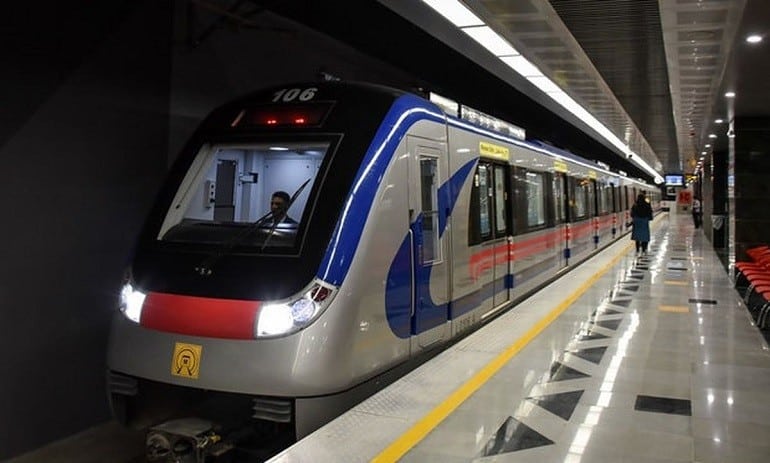
Isfahan Metro is a metro system serving the city of Isfahan, Iran.
The first phase of Line 1 runs for 11 km from Qods in the northwest to Shohada via Kaveh (Northen long-distance bus terminal) to Sofeh (Southern long-distance bus terminal). A single journey costs IRR28000 (November 2022) you can buy multi-journey contactless cards at any metro station ticket seller offices.
Ride-Sharing Apps
It is recommended for traveler to use the ride-sharing apps such as SNAPP or TAP30 since they are cheaper than the regular taxi most of the time.
What To See in Isfahan?
Squares and streets

Naqsh-e Jahan Square also known as shah square or imam square-1602. The square contains two mosques, a palace, and the bazaar. The square is the largest historic public square in the world after Tiananmen Square in [[Beijing]] and it is one of UNESCO’s World Heritage Sites. The square is surrounded by buildings from the Safavid era. This a very popular place for locals to picnic on Friday and holiday evenings.
Meydan Kohne (Kohne Square)
Shahshahan Square
Chaharbagh Boulevard: 1596, dating from the Safavid era, the avenue is the most historically famous in all of Persia.
Chaharbagh-e-khajou Boulevard
Mosques
The stunning mosques of Isfahan are among the most beautiful and interesting in the world.
* Built during the Safavid period, it is an excellent example of Islamic architecture of Iran, and regarded as one of the masterpieces of Persian Architecture. It is registered as a UNESCO World Heritage Site. Its splendor is mainly due to the beauty of its seven-colour mosaic tiles and calligraphic inscriptions.
Sheikh Lotf Allah Mosque
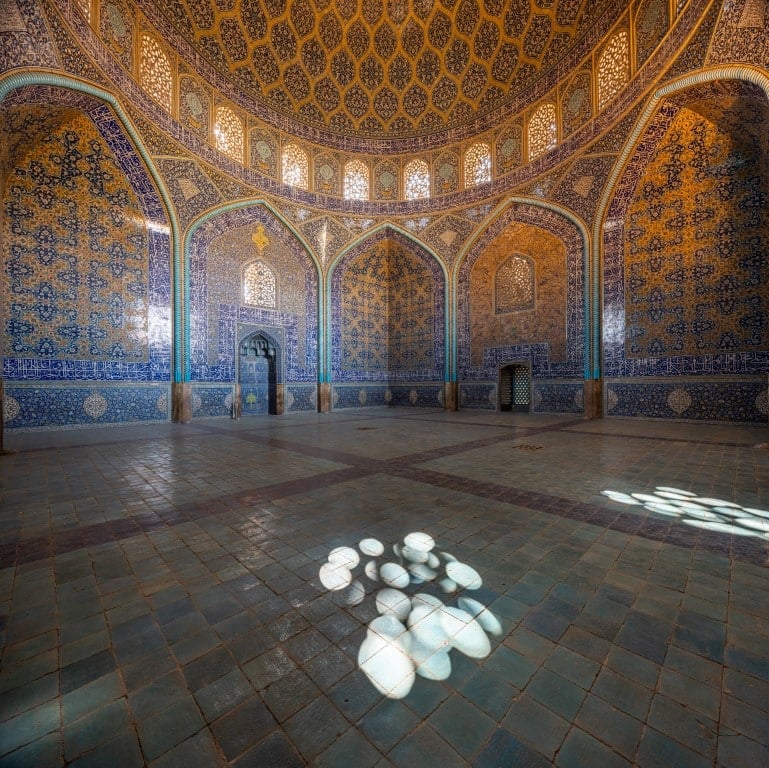
one of the architectural masterpieces of Safavid Iranian architecture, this mosque is considered to be the most beautiful in Iran. Built-in 1602 by Shah Abbas I.= and designed by his chief architect, Sheikh Bahai. The mosque was designed to be a private mosque for the royal family and therefore it does not have any minarets. There is a tunnel from the mosque to the Royal Palace, across the square.
Hakim Mosque
one of the oldest mosques in Isfahan. Built by Shah Abbas II between 1656 and 1662. Located on the site of a 10th-century mosque. The portal was covered in mud until it was discovered in 1956.
* Started in AD842, this is the first Islamic building to adapt the four-courtyard layout of Sassanid palaces
Palaces

Ālī Qāpū (The Royal Palace) – Early 17th Century. It is forty-eight meters high and there are seven floors, each accessible by a difficult spiral staircase. In the sixth-floor music room, deep circular niches are found in the walls, having not only aesthetic value but also acoustic. It is rich in naturalistic wall paintings by Reza Abbassi, the court painter of Shah Abbas I, and his pupils. There are floral, animal and bird motifs.
Talar Ashraf (The Palace of Ashraf) – 1650.
Hasht Behesht (The Palace of Eight Paradises) – 1669: Reportedly built for residence purposes of the King’s harem.

Chehel Sotoun (The Palace of forty columns) – 1647: It is called Palace of forty columns, as there are many columns, and in Iranian, 40 means many. Incidentally, there are twenty columns, and these are reflected in the pool in front, which might also account for its name. The function of this palace was for holding religious-national ceremonies and royal festivals and for receiving royal ambassadors and guests.
Schools
Madreseye Sadr (Sadr school)

Madreseye Shah (Imam Jafar Sadegh after the revolution). The compound was built during Soltan Hossein, a Safavid king, to serve as a theological and clerical school to train those who were interested in such sciences. The dome and the greater part of the walls are covered in bright yellow bricks which give a feeling of lightness. The entrance gate decorated with gold facade and silver and the tile-works inside the building are masterpieces of fine art and industry. The central court, with its pool and garden, are surrounded by arcades on two levels, each giving access to a student’s room.
Bridges
Walk along the Zayanderud River beside the ancient bridges. You see many locals doing this every day. However, as a result of a drought and badly planned dam, there is usually no water in the river.

Pol-e Shahrestan (The Shahrestan Bridge) – 11th Century. It is one of the oldest surviving bridges in Iran, built in the 14th Century (C.E.).
Pol-e Khaju (Khaju Bridge) – 1650. It is the finest bridge in the province of Esfahan. It was built by the Persian Safavid king, Shah Abbas II around 1650 C.E. This structure originally was ornated with artistic tile works and paintings serving as a teahouse.

Si-o-Seh Pol (The Bridge of 33 Arches) – 1602. It is highly ranked as being one of the most famous examples of Safavid bridge design.
Pol-e-Joui or Choobi(Joui bridge)It is one of Isfahan’s oldest bridges and was built in 1665, during the Safavid era.
Pol-e-Maarnaan (Maarnaan Bridge)
Churches and Cathedrals
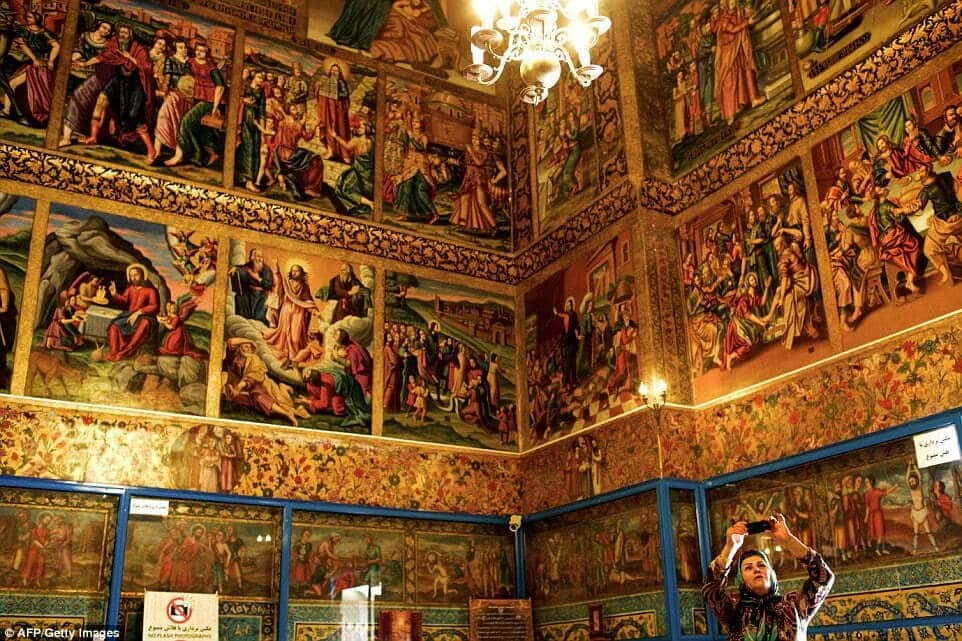
Vank Cathedral (The Church of the Saintly Sisters) – 17th century. The interior is covered with fine paintings and gilded carvings and includes a wainscot of rich tile work. The delicately blue and gold painted central dome depicts the Biblical story of the creation of the world and man’s expulsion from Eden. Right above the entrance, there is an interesting fresco of heaven and hell with black and brown devils slaughtering white naked people who obviously sinned. To heaven go well dressed pious people with candles. Entrance to the compound on which there is also a museum: IRR200,000. Good value compared to what you pay at other sites.
Kelisaye maryam (maryam church)
Modern Isfahan
Isfahan City Center which is recently completed and now serving the visitors with its variety of products and services, such as a museum, a Food court with traditional and international meals, an Art Gallery, the largest shopping mall in Iran with local and international brands, The largest indoor amusement park in Iran. You can spend a whole week exploring its facilities.

Modern Restaurants such as Shab Neshin, Kentucky House, Hermes, …
Modern Amusement Parks such as Isfahan City Center amusement Park, Simorgh Amusement Park and Dreamland Amusement Park east of Isfahan.
Kids Club Sofia Kids Club is the best kids club in Esfahan. They can keep and educate your children in English language. The price is about 3 US Dollars per hour.it is consists of Coffee shop, rock climbing, children`s sand game etc. Tel +983132605725
Address: No.177, Ghorbanian Deadend, Bazarcheh st., Second Moshtagh (Near Shahrestan Bridge).
Other sights
Atashgah: a Zoroastrian fire temple. This small reconstructed temple and ruins are dramatically set atop a rock on the outskirts of Isfahan and provide a commanding view of the smog-covered city. You can take one of the blue buses there (ask the drivers). Alternatively, you can cycle the 15 km from the city along the river bank. Entry: IRR 150,000 for foreigners. Free for Iranians.

Buqe’h-ye Ibn-Sina (Avicenna’s Dome) – 12th Century.
The Tombs of Nizam al-Mulk & Malek Shah: 12th & 18th Century.
Jolfa: The Armenian Quarter, it includes one of the most beautiful churches in Iran.
Sheikh Bahai Bathhouse: falling apart due to neglect.
Pigeon Towers: Built in the 17th century to attract pigeons, whose feces were then used as fertilizer.
Hamam-e (Bathhouse) Ali Gholi Agha located in a pleasantly quiet neighborhood with many silver and bronze smiths.
What To Do in Isfahan

- Take a taxi to the south of the city to Soffeh Mountain and catch a telecabin up for IRR500,000 or go bowling at the only bowling alley in the city underneath the telecabin station.
- Walk along beautiful Zayanderood river and enjoy well maintained parks and historic bridges on the ways.
- Enjoy a horse-drawn carriage ride in the historic Naqshe-Jahan square.
- Have a picnic in Nazhvan garden and enjoy the scenery
- Take a walk in Chahar-Bagh street while enjoying Persian saffron ice-cream
- Take a day trip to Kashan and Qamsar, especially during the months that local Rosewater production is underway in Qamsar.
What To Buy in Isfahan?
Note that shops in the main square must pay an additional 8% tax on sales, which is passed on to the customer. Unless the item that you are purchasing is unique or inexpensive, you may be better off shopping outside of the main square.
Isfahan, often referred to as “Half the World,” is not just a city of mesmerizing mosques, historic bridges, and serene gardens; it is also a hub of traditional Iranian arts and crafts. As you meander through the winding bazaars, the scent of spices wafting through the air and the gentle sounds of artisans at work, you’ll find treasures that are quintessentially Isfahani. Here’s a guide to what to buy in Isfahan to take a piece of this Persian gem home with you.
1. Persian Carpets and Rugs

Isfahan is famed for its handwoven carpets and rugs, each telling a unique story through intricate patterns and vibrant colors. These carpets are not just floor coverings; they are works of art, painstakingly crafted over months or even years. While they might be a pricier keepsake, owning an Isfahani carpet is like having a piece of Persian history in your living room.
2. Miniature Paintings
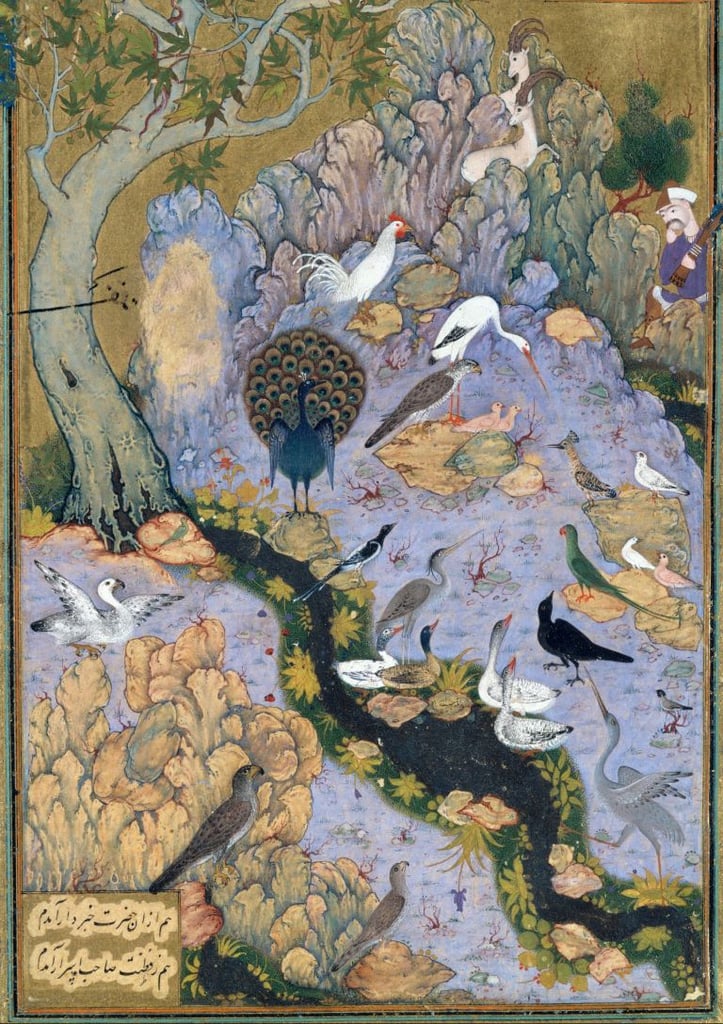
The art of miniature painting has been cherished in Iran for centuries. These delicate and finely detailed paintings often depict scenes from Persian myths, poetry, or everyday life. Visit the art galleries around Naqsh-e Jahan Square to find an original piece or even get a personalized miniature painting as a unique souvenir.
3. Khatamkari (Marquetry)

Khatamkari is the art of crafting intricate geometric patterns from thin pieces of wood, bone, and metal. You’ll find this beautiful inlay work on boxes, frames, chess boards, and even furniture. Each piece, with its meticulous detailing, is a testament to the artisan’s dedication and skill.
4. Hand-painted Tiles
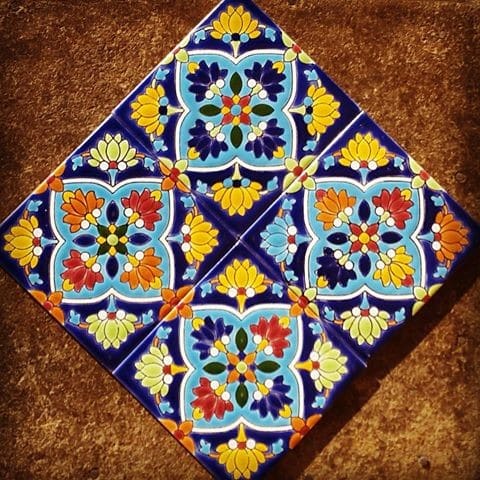
Reflecting the grandeur of Isfahan’s mosques and palaces, hand-painted tiles are a popular item among tourists. These tiles, adorned with floral motifs, Persian calligraphy, and scenes from folklore, make for beautiful wall hangings or coasters.
5. Traditional Sweets and Nougats

No trip to Isfahan is complete without indulging in its mouth-watering sweets. Gaz, a nougat made from the sap of the Angebin plant, mixed with rosewater, pistachios, and almonds, is a must-try. Pack some in beautiful boxes as gifts or simply enjoy them with a cup of Iranian tea.
6. Termeh

Termeh is a luxurious handwoven fabric, traditionally used for ceremonial clothing. Today, it’s fashioned into tablecloths, shawls, and cushion covers, all boasting rich colors and intricate designs. A piece of Termeh is a vibrant reminder of the textiles of Isfahan.
7. Qalamzani (Metal Engravings)
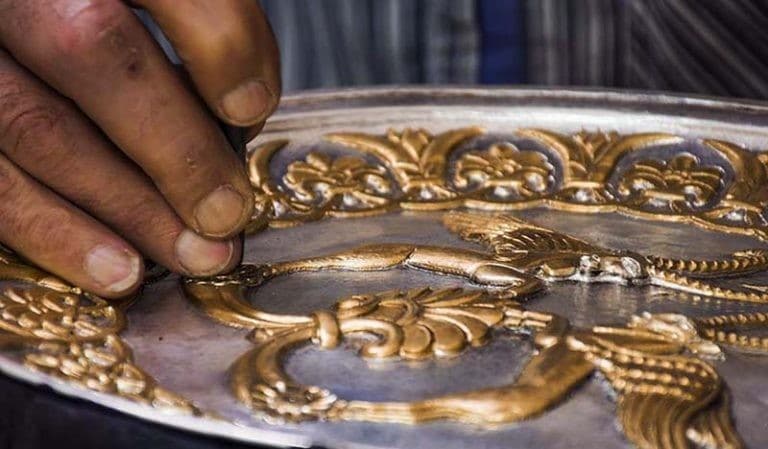
Isfahan is renowned for its brass and copperware, especially items adorned with Qalamzani – the art of engraving intricate designs on metal. From vases and trays to ornamental pieces, these items shimmer with tales of Persian legends and motifs.
8. Pottery and Ceramics

Isfahani pottery, with its distinctive blue and turquoise glaze, can add a touch of Persian elegance to any home. Bowls, plates, and decorative items, often adorned with poetic inscriptions, are popular choices among visitors.
What To Eat in Isfahan?
In some parks, you can simply obtain a carpet and tea from the park warden, and have a picnic on the grass! You will find families gather in these parks, and bring barbecues and cook freshly made kebabs, which smell (and taste) delicious.
Local foods in Isfahan
- Chelo kebab (kebab with rice) is a must; there are regional variations in Isfahan.
- Beryani is a popular and tasty lunch dish in Isfahan. Many visitors wrongly call it “Biryani” which refers to the place that sells Bryan. This local dish is made of sheep meat and lung. Although it is generally known as a fatty dish if you would like to try it you may order a dietary one.
- Fereni & Shireh (Fereni= A concoction of cereal, rice flour, water, and milk) at Fereni Hafez, which is along Hafez Street near Imam Square. Usually, they mix it with date essence. It costs IRR15000 for a small bowl or IRR25000 for a bigger one.
- Khoresht mast is a popular dessert dish, only made in Isfahan. It is a sweet yellow pudding, which literally means “Yogurt Stew”. Saffron, meat, and yogurt are among the main ingredients.
- Doogh-o-Gooshfil a strange combination of Doogh (yogurt drink – usually salty/sour) and Gooshfil (kind of sweet)
Accommodations in Isfahan
BOOK ONLINE
Isfahan Hotels
The Best 5-Star Hotels in Isfahan
1. Abbasi Hotel Isfahan
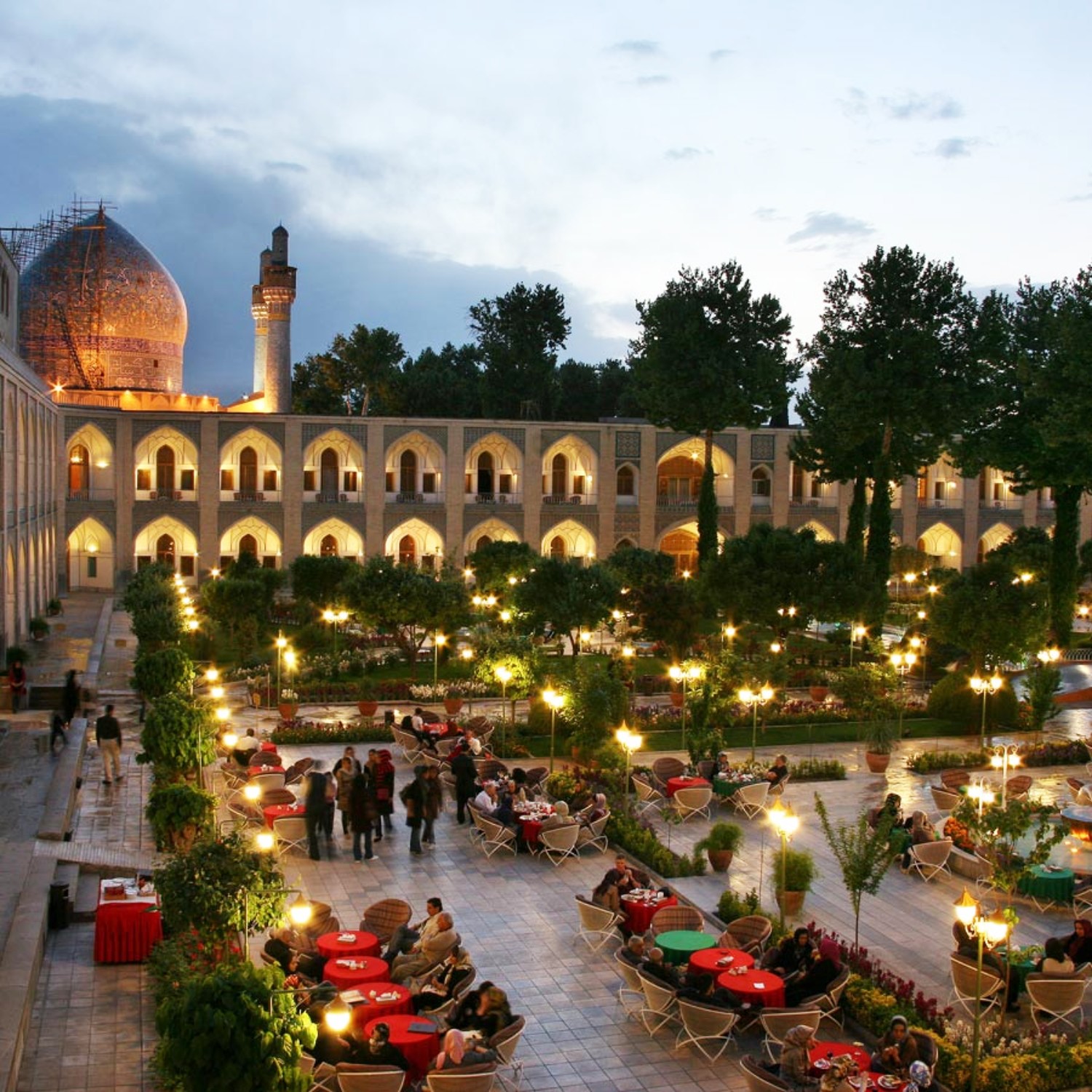
Experience Isfahan’s premier five-star lodging at Abbasi Hotel. With a 300-year heritage, this iconic hotel blends Persian elegance with modern comforts. Located on Chaharbagh Abbasi Street, it offers 225 rooms, four banquet halls, and multiple dining options. Enjoy stunning views of the Chaharbagh Mosque’s dome and easy access to historical sites like Naqsh-e Jahan Square. From diverse room choices to leisure amenities like a swimming pool and traditional tea house, the Abbasi Hotel ensures a memorable stay. Book with OrientTrips for an unparalleled experience in the heart of Isfahan’s living history.
2. Kowsar Hotel Isfahan
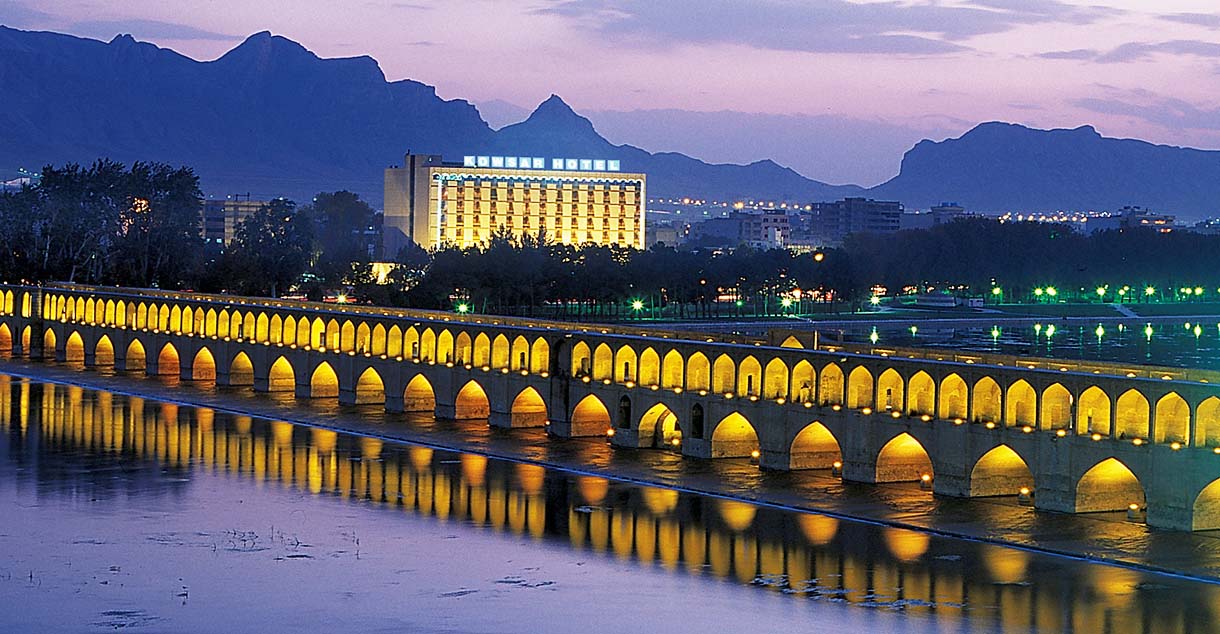
Kowsar Hotel in Isfahan blends heritage and modernity. Originally Kourosh Hotel, it now shines as Kowsar Parsian Hotel. With 225 rooms across seven floors, it offers diverse accommodations. From single rooms to royal double suites, guests can choose their preferred style in the distinctive turquoise building. Special amenities include a restaurant, swimming pool, and green spaces. Free parking, internet, sauna, gym, laundry, beauty salon, and tour services ensure convenience. Kowsar Hotel is a gateway to Isfahan’s cultural riches, with a strategic location and comprehensive offerings. Book your stay via OrientTrips for a harmonious blend of tradition and contemporary service.
3. Attar Hotel Isfahan
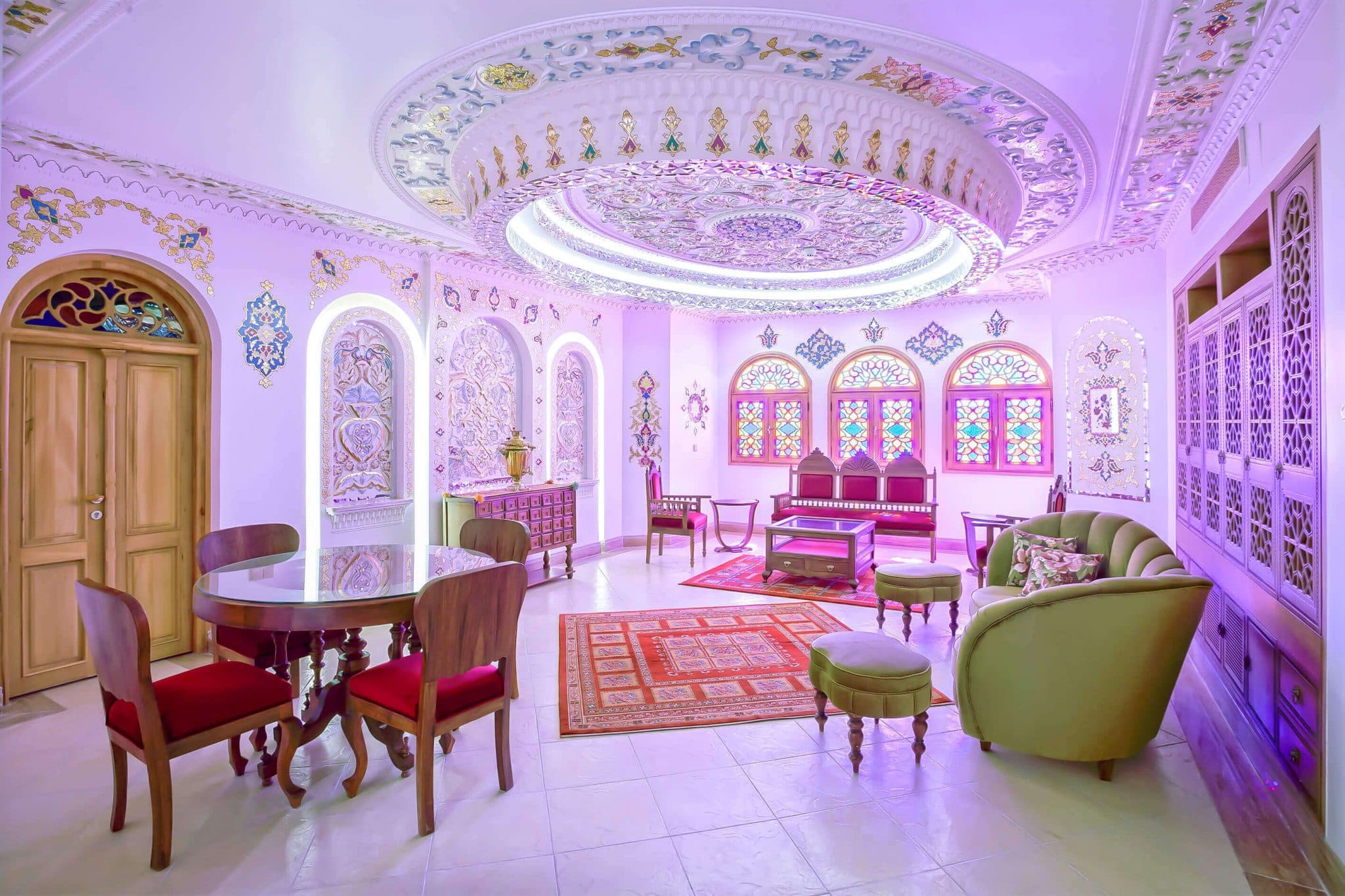
Discover the captivating Attar Hotel in Isfahan, renowned for its traditional design and rich artistry. Each room is adorned with exquisite Isfahani arts, providing an enchanting experience. With limited double and four-person suites, enjoy an intimate and luxurious atmosphere. The interior reflects a blend of Islamic-Iranian and Isfahan art, immersing guests in Persian culture. Unwind in the swimming pool, jacuzzi, and gym, or indulge in the indoor pool and traditional Turkish bath. Conduct business in the conference hall and stay connected with free lobby internet. Additional amenities include taxi services, complimentary breakfast, 24/7 reception, secure safe deposit boxes, and ample parking. Attar Hotel ensures a memorable stay.
The Best 4-Star Hotels in Isfahan
4. Piroozy 4-Star Hotel in Isfahan
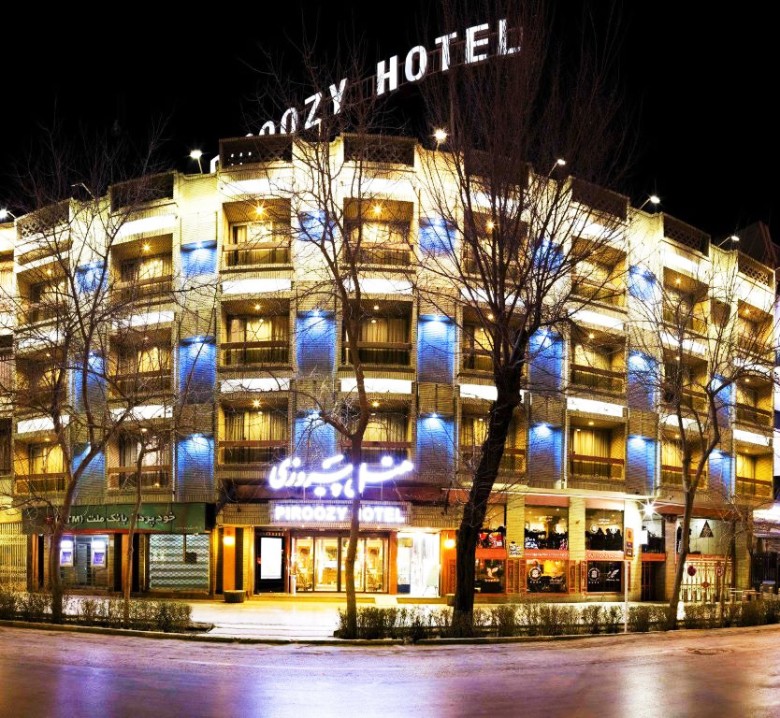
Introducing the 4-star Piroozy Hotel, formerly known as Dariush Hotel. Renovated in 2017, it offers upgraded services and easy access to Isfahan’s historical landmarks. Situated on the green edge of the historic Chaharbagh, this beautiful hotel is conveniently located near Chehel Sotoun Palace, Museum of Contemporary Arts, Hasht Behesht Palace, and more. With five floors and 95 rooms, including single, double, and twin rooms, as well as one-bedroom suites for two people, the Piroozy Hotel caters to various accommodation needs. Enjoy special facilities such as a 250-person restaurant, free parking for 35 cars, and complimentary internet in the lobby. Additional amenities include free airport transfer, travel agency services, and a coffee shop.
5. Ali Qapu Hotel

Ali Qapu Hotel, one of Isfahan’s finest, offers a luxurious experience since its establishment in 1967. Recently renovated in 2017, the hotel guarantees top-notch services. Strategically situated near Isfahan’s renowned tourist attractions like Khaju Bridge, traditional palaces, Si-o-se Pol, and Naqsh-e Jahan Square, it ensures convenience for travelers. With four floors and a total of 106 rooms, the hotel offers a range of accommodation options, including single, double, twin, small and large suites, and triple rooms. Additional amenities encompass a 150-person capacity restaurant, complimentary parking for 40 cars, free lobby internet, swimming pool access, currency exchange, sauna, taxi service, internet cafe, ticketing services, laundry, 24-hour reception, green space, store, coffee shop, and jacuzzi.
6. Safir Hotel, Isfahan

Discover the Safir Hotel, a leading 4-star establishment in Isfahan. With its strategic location near the Art Bazaar, Chahar Bagh Street, Abbasi Complex, and Naqsh-e Jahan Square, guests can easily explore the city’s renowned attractions. The hotel offers 100 rooms across six floors, ranging from cozy doubles to spacious suites and apartments. Enjoy the convenience of a restaurant, complimentary lobby internet, a swimming pool, safe deposit boxes, a store, taxi service, car rental, and a 24-hour reception. Additional amenities include a coffee shop, ATM, and currency exchange. Experience exceptional comfort and convenience at the Safir Hotel Isfahan.
Best 3-Star Hotels in Isfahan
7. Setareh Hotel Isfahan

Introducing Setareh Hotel, a fusion of traditional and modern architecture, nestled in the historic context of Isfahan. Renowned as one of the finest hotels in Isfahan, Setareh Hotel offers an exceptional advantage with its prime location near iconic landmarks like Naqsh-e Jahan Square, Ali Qapu Palace, and Imam Mosque. With 52 rooms spread across 3 floors, the hotel provides a range of accommodation options, including single and double rooms, twin rooms, suites, and more. Noteworthy amenities include a restaurant for 150 guests, free parking for 25 cars, unlimited internet in the lobby, and a traditional teahouse.
8. Safavi Hotel Isfahan

Safavi, a top 3-star hotel in Isfahan, offers an authentic Safavid-era experience. Renovated in 2017, our 6-floor hotel showcases the art and architecture of that period. Choose from our 40 rooms: single, standard double, twin, Safavi double, Safavi twin, triple, quadruple, or quintuple. Enjoy our special features like a 100-person restaurant, free parking for 100 cars, unlimited lobby internet, a traditional teahouse, coffee shop, porter service, facilities for disabled guests, ticketing and tour services, a movie network, and taxi service.
9. Parsian Suite Hotel Isfahan

Discover Isfahan’s best at Parsian Suite Hotel. Renovated in 2015, this 3-star hotel is part of the esteemed Parsian International Hotels chain. Located downtown, near the Zayandeh River, it provides easy access to historical sites. With 52 rooms across 3 floors, we offer options for every traveler, from singles to families. Enjoy our restaurant, free lobby internet, store, housekeeping, dry cleaning, and optional transfers. Experience comfort and convenience at Parsian Suite Hotel, your ideal choice in Isfahan.
Read More




